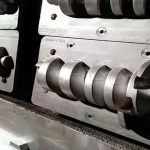1. Reasonable selection and dressing of grinding wheels
The grinding wheel of white corundum is better. Its performance is hard and brittle, and it is easy to produce new cutting edges. Therefore, the cutting force is small and the grinding heat is small. The medium particle size is used, such as 46 to 60 mesh. The hardness of the grinding wheel is medium soft and soft (ZR1, ZR2 and R1, R2), that is, coarse-grained, low-hardness grinding wheels, and good self-excitation can reduce cutting heat. It is very important to choose an appropriate grinding wheel for fine grinding. For the high vanadium and high molybdenum condition of the mold steel, it is more suitable to choose GD single crystal corundum grinding wheel. When processing cemented carbide and materials with high quenching hardness, the organic binder diamond is preferred. Grinding wheels, organic binder grinding wheels have good self-grinding properties, and the roughness of the ground workpieces can reach Ra0.2μm. In recent years, with the application of new materials, CBN (cubic boron nitride) grinding wheels have shown very good processing results. Finishing on CNC forming grinder, coordinate grinder, Cnc internal and external cylindrical grinder, the effect is better than other types of grinding wheels. In the grinding process, attention should be paid to dressing the grinding wheel in time to keep the grinding wheel sharp. When the grinding wheel is passivated, it will slip and squeeze on the surface of the workpiece, causing burns on the surface of the workpiece and reducing its strength.
2. Reasonable use of cooling lubricant
Play the three functions of cooling, washing and lubrication to keep cooling and lubrication clean, so as to control the grinding heat within the allowable range to prevent thermal deformation of the workpiece. Improve the cooling conditions during grinding, such as the use of oil-immersed grinding wheels or internal cooling grinding wheels. Introduce the cutting fluid into the center of the grinding wheel, the cutting fluid can directly enter the grinding area, play an effective cooling role, and prevent burns on the surface of the workpiece.
3. Reduce the quenching stress after heat treatment to a minimum
Because of the quenching stress and the net-like carbonized structure under the action of the grinding force, the phase change of the structure can easily cause cracks in the workpiece. For high-precision molds, in order to eliminate the residual stress of grinding, low temperature aging treatment should be carried out after grinding to improve toughness.
Grinding tool grinding machine: grinding001
Abrasive Tool Technology|Grinder Application|Grinding Technology|Wheel Selection
4. Eliminate grinding stress
The mold can also be immersed in a salt bath at 260~315℃ for 1.5 min, and then cooled in 30℃ oil, so that the hardness can be reduced by 1HRC and the residual stress can be reduced by 40%~65%.
5. Constant temperature grinding
For precision grinding of precision molds with dimensional tolerances within 0.01 mm, attention should be paid to the influence of ambient temperature, and constant temperature grinding is required. From the calculation, it can be seen that for a 300mm long steel, when the temperature difference is 3℃, the material will have a change of about 10.8μm, (10.8=1.2×3×3, the deformation per 100mm is 1.2μm/℃), and each finishing process needs to be fully considered The influence of this factor.
6. Using electrolytic grinding processing
Improve mold manufacturing accuracy and surface quality. During electrolytic grinding, the grinding wheel scrapes off the oxide film: instead of grinding the metal, the grinding force is small, the grinding heat is also small, and there will be no grinding burrs, cracks, burns, etc. The general surface roughness can be better than Ra0 .16μm; In addition, the wear of the grinding wheel is small, such as grinding cemented carbide, the wear of silicon carbide grinding wheel is about 400% to 600% of the weight of the cemented carbide that is ground. When electrolytic grinding is used, the wear of the grinding wheel Only 50% to 100% of the removal of cemented carbide.
7. Reasonably choose the amount of grinding
It adopts fine grinding method with small radial feed, even fine grinding. If the radial feed rate and the grinding wheel speed are appropriately reduced, and the axial feed rate is increased, the contact area between the grinding wheel and the workpiece is reduced, and the heat dissipation conditions are improved, thereby effectively controlling the increase in surface temperature.
Mold Wiki provides you with the most comprehensive plastic, plastic, mold, mold design, decoration knowledge points of plastic mold brands, and shopping guide and online shopping services for various plastic molds, with the cheapest plastic mold prices and the best quality after-sales service. Please visit Mold Wiki: https://mold.wiki/Keywords of the article: plastic; related plastic products:
Link to this article:Some practical tips for reducing defects in die processing
Reprint Statement: If there are no special instructions, all articles on this site are original. Please indicate the source for reprinting:Mold Wiki,Thanks!^^

